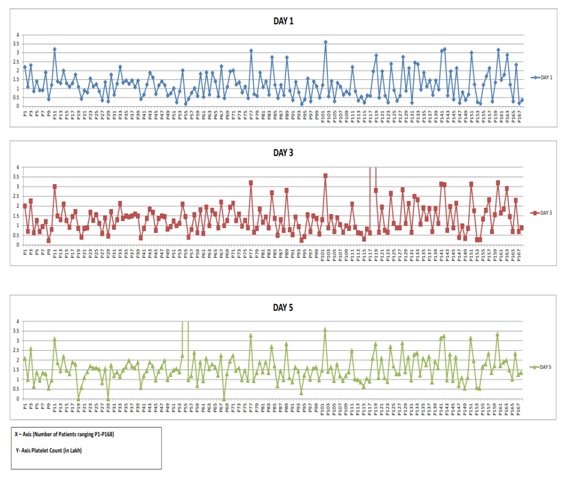Study of incidence and severity of thrombocytopenia in childhood malaria and response to antimalarial therapy in a tertiary care hospital
Abstract
Background: Malaria is a significant cause of morbidity and mortality all over world and India contributes a significant proportion of disease. There is relative paucity of data in children regarding incidence of thrombocytopenia, its severity, clinical manifestations and response to anti-malarial treatment.
Materials and methods: The study conducted in a tertiary care hospital in south Rajasthan in over a period of one year includes 168 children less than 16 years with diagnosed case of malaria. Data were collected according to the medical records observation technique.
Results: We found significant association of thrombocytopenia in malaria. Majority of cases with thrombocytopenia were plasmodium vivax positive, range of platelet count was 16000/cumm to 3.2lacs/cumm. Despite severe thrombocytopenia, no child had bleeding manifestations and response to treatment was significant and platelet transfusion was given to none.
Conclusion: Thrombocytopenia in a febrile child in endemic zones should alert the physician towards the possibility of malaria. Moreover even in cases of severe thrombocytopenia, one should not panic and shouldgive anti-malarial and appropriate supportive therapy as bleeding manifestations are rare and response to therapy is good.
Downloads
References
2. Gill MK, Makkar M, Bhat S, Kaur T, Jain K, Dhir G. Thrombocytopenia in malaria and its correlation with different types of malaria. Ann Trop Med Public Health 2013; 6: 197-200.
3. Shiraz Jamal Khan YA, Mumtaz Ali M: Thrombocytopenia as an Indicator of Malaria in Adult Population. Malar Res Treat. 2012, 405981: 1-4.[pubmed]
4. Khattak AL, Ali W, Khan NA, Satti L, Idris M. Response of Plasmodium vivax malaria induced thrombocytopenia to antimalarial treatment. JAMCA. 2014;26:463–5.[pubmed]
5. Meena KR, Kumar A. Thrombocytopenia in children with malaria - A study from tertiary care Hospital Delhi, India. IJSRP. 2013; 3(8):1-3.
6. Kumar S, Khan N. Prevalence and Detection of Malaria at a Tertiary Care Hospital in Southern Rajasthan, India. Int. J. Curr. Microbiol. App. Sci.2016; 5(8): 663-668.[pubmed]
7. Schumacher RF, Spinelli E. Malaria in Children. J. Hematol. Infect. Dis. 2012; 4:e2012073. Doi: 10.4084/mjhid.2012.073. [pubmed]
8. Thapa R, Biswas B, Mallick D, Sardar S, Modak S. Childhood Plasmodium vivax malaria with severe thrombocytopenia and bleeding manifestations. J Pediatr Hematol Oncol. 2009; 31:758–9.
9. Tanwar GS, Khatri PC, ChaharCK, Sengar GS, Kochar A, et al. (2012) Thrombocytopenia in childhood malaria with special reference to P. vivax monoinfection: A study from Bikaner (Northwestern India). Platelets 23: 211–216. Doi: 10.3109/09537104.2011.607520
10. Faseela TS, Ronald RA, Anita KB, Malli CS, Rai Y. Diagnostic value of platelet count in malaria. Journal of clinical and diagnostic research, 2011; 5(3):464-66.
11. Omar, Balram M, Kriti, Singh D, Anuradha S. Thrombocytopenia with bleeding manifestations in childhood malaria. The Indian journal of child health.2016; 3: 1-4.
12. Horstmann R.D., Dietrich M, Bienzle U, Rasche H. Malaria induced thrombocytopenia. Annals of Hematol. 2005; 42(3):157-64.[pubmed]
13. Maina RN, Walsh D, Gaddy C, Hongo G, Waitumbi J, Otieno L, et al. Impact of Plasmodium falciparum infection on hematological parameters in children living in Western Kenya. Malar J. 2010;9(suppl 3):S4.
14. González B, Rodulfo H, De Donato M, Berrizbeitia M, Gómez C, González L. Hematologic variations in patient with malaria caused by Plasmodium vivax before, during and after treatment. Invest Clin. 2009; 50:187–201.[pubmed]
15. Park JW, Park SH, Yeom JS, Huh AJ, Cho YK, Ahn JY, et al. Serum cytokine profiles in patients with Plasmodium vivax malaria: A comparison between those who presented with and without thrombocytopenia. Ann Trop Med Parasitol. 2003; 97(7):339-44.
16. Ohtaka M, Ohyashiki K, Iwabuchi H, Iwabuchi A, Lin KY, Toyama K. A case of vivax malaria with thrombocytopenia suggesting immunological mechanisms.RinshoKetsueki. 1993; 34:490-2.[pubmed]
17. Lee SH, Looareesuwan S, Chan J, Wilairatana P, Vanijanonta S, Chong SM, et al. Plasma macrophage colony-stimulating factor and P-selectin levels in malaria-associated thrombocytopenia. ThrombHaemost. 1997;77(2):289-93.[pubmed]
18. Erel O, Vural H, Aksoy N, Aslan G, Ulukanligil M. Oxidative stress of platelets and thrombocytopenia in patients with vivax malaria. ClinBiochem. 2001; 34(4):341-4.[pubmed]
19. Coelho HC, Lopes SC, Pimentel JP, Nogueira PA, Costa FT, Siqueira AM, et al. Thrombocytopenia in Plasmodium vivax malaria is related to platelets phagocytosis. PLoS One. 2013; 8:e63410.[pubmed]
20. Aduragbenro DA, Catherine OF, Rachel TK, George OA. Age as a risk factor for thrombocytopenia and anemia in children treated for acute non complicated falciparum malaria. J Vector Borne Dis. 2007; 44:266-71.[pubmed]
21. Gérardin P, Rogier C, Ka AS, Jouvencel P, Brousse V, Imbert P: Prognostic value of thrombocytopenia in African children with falciparum malaria. Am J Trop Med Hyg 2002, 66:686-691.[pubmed]
22. Moulin F, Lesage F, Legros A-H, Maroga C, Moussavou A, Guyon P, Marc E, Gendrel D: Thrombocytopenia and Plasmodium falciparum malaria in children with different exposures. Arch Dis Child 2003, 88:540-541.

Copyright (c) 2018 Author (s). Published by Siddharth Health Research and Social Welfare Society

This work is licensed under a Creative Commons Attribution 4.0 International License.


 OAI - Open Archives Initiative
OAI - Open Archives Initiative


